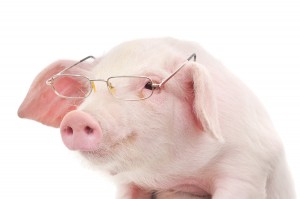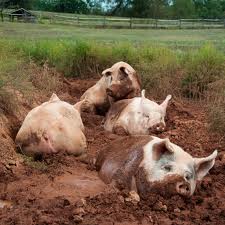
Since reading Berger’s and Walker’s passages in class, I cannot say that I have a radically new and enlightened view on how animals are depicted. However, I can say that those passages help me view these depictions in a slightly new way by shedding new light. Viewing the way farm animals are treated has always been an issue important to me. Nowadays, producers and distributors of meat products have tried there best to unanthropomorphism the connections between animals and humans. They focus on engraving only the instrumental value of animals in the minds of the consumer, as opposed to the intrinsic values.
Seeing images like the one posted above, is not the most common image of a pig that most see. This picture depicts what looks like a very intelligent pig. The pig is in a position similar to what the “quintessential librarian” looks like- glasses and posture together. The pig looks soft and clean. It even looks like the pig has a grin.
 Most would say that this image is what pops in ones head when one thinks of pigs. Now it isn’t a bad thing to associate pigs playing in mud, since it is natural for them. However, by reinforcing this image in ones head, one subconsciously propagates the stereotypes and prejudices society has instilled with pigs- which is that they are dumb, dirty, fat, and nasty.
Most would say that this image is what pops in ones head when one thinks of pigs. Now it isn’t a bad thing to associate pigs playing in mud, since it is natural for them. However, by reinforcing this image in ones head, one subconsciously propagates the stereotypes and prejudices society has instilled with pigs- which is that they are dumb, dirty, fat, and nasty.
Reading Berger has shown me the deviations, as a society, we have taken in our previously dualistic mindset. We used to treat animals with respect and value, respecting their intrinsic value and instrumental value at the same time (1). Today, we don’t even go that far in respecting them. Alice Walker makes a point in Am I Blue? where she opens conversation about the way we treat animals is similar to the way we treat minorities- for instance, the way white people treated black people during slavery in the United States. If one witnesses how a factory farm operates, one would be appalled in the treatments of the animals. You could equate the way the pigs and other animals are being treated to conditions slaves endured.
Most are not aware of the intelligence that pigs have. Hence why, the producers of the first image created the picture. They made the pig appear intelligent. They are tying to start a conversation to break down the common misconceptions society holds on the intellect of farm animals. Some scientists believe even that pigs are smarter than dogs, smarter than dolphins, smarter than 3-year-olds (2). So if in society we really choose the food we eat by its intelligence- we will not eat monkeys, dogs, cats, etc. due to their intellect but we will eat a cow, pig, and chicken because of their inferior intelligence-, I believe we will see many contradictions arising from scientific data on the actual intelligence of farm animals.
Now, I am not advocating that we all become vegetarians and completely cut out meat from our diets; however, I believe this quote sums up my thoughts quite well:
“If we’ve decided to eat pigs despite the fact that they are smart, should we not at least use the information that we have to make their lives as positive as possible up until the point when we decide, “Well now they’ve become food?”
Sources:
(1) Berger, John. “Why Look At Animals?” About Looking. New York: Pantheon, 1980. 7. Print.
(2) “Pigheaded: How Smart Are Swine?” Modern Farmer. N.p., n.d. Web. 13 Sept. 2014.
(3) Walker, Alice. “Am I Blue?” Other Nations: Animals in Modern Literature. Ed. Tom Regan and Andrew Linzey. Waco, TX: Baylor UP, 2010. N. pag. Print.
I really found that quote at the end interesting. This reminds me of the “Bacon” image that we discussed in class. So are you saying that anthropomorphizing this pig in the image is a positive thing because it helps the audience change their stereotypical negative view of pigs?
Yes, exactly! The problems with stereotypes is not that they are untrue- but that they are incomplete. So the image of the pigs in the mud isn’t inaccurate since they naturally go into the mud to cool down; however, because we only identify pigs with the mud we, for the most part, only identify pigs as dirty, dumb, etc. The image with the pig in glasses showcases another side of pigs that we don’t typically associate with them. It begins to breakdown the stereotype for them.